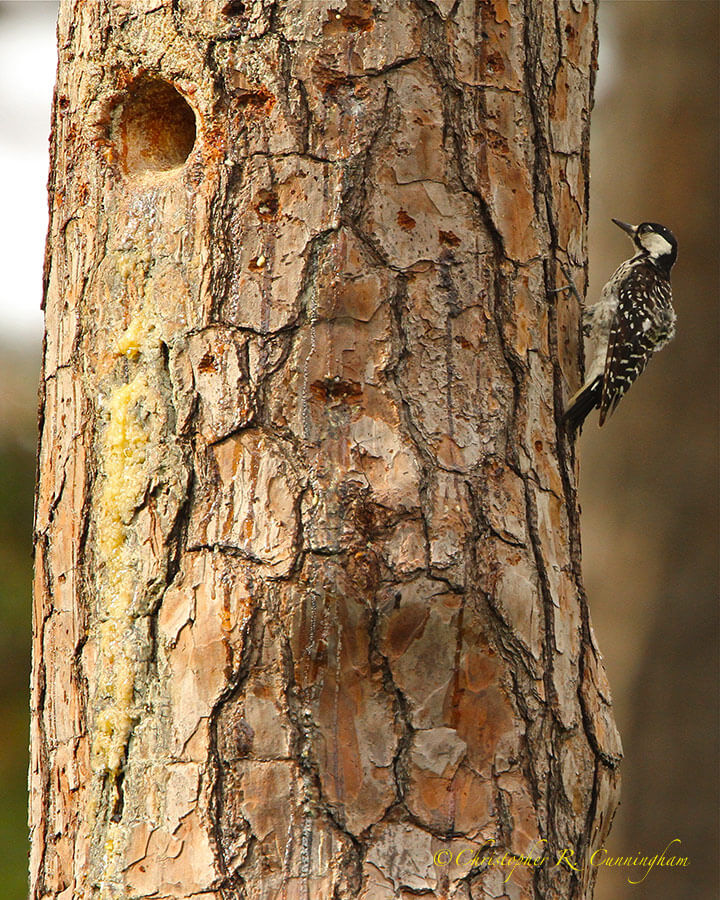I heard myself proclaimed,
And by the happy hollow of a tree
Escaped the hunt . . . . from King Lear, William Shakespeare

One of the places we made a special point to visit while at Rocky Mountain National Park was a notable large, dead Ponderosa Pine at Upper Beaver Meadows. A birder friend from Houston Audubon (SM) first told us about The Tree when we mentioned that we were going to RMNP. We tried in vain several times to find it on our own, but finally a park ranger explained exactly where it was. The Tree turned out to be a spectacular spot to photograph cavity nesting birds. In this tree alone we saw Mountain Bluebirds, Red-naped Sapsuckers, Pygmy Nuthatches, House Wrens, and Violet-green Swallows nesting. A Northern Flicker even came by and checked out the Bluebird nest as if to say: “What are you doing in my cavity? I dug it, you squatter!”
Five species nesting in one tree beats our previous record of seeing Pileated, Downy, and Red-bellied Woodpeckers, plus Prothonotary warblers nesting in a single tree at BBSP. But The Tree likely contains even more nesting species as there were more holes and several other species of cavity nesters are very common in the area, namely Hairy Woodpeckers and American Tree Swallows (not to mention Western Wood-Peewees). The mind reels at the thought of a single tree with eight or more cavity-nesting species inside!


A place we’ve been meaning to spend some more time looking for cavity nesters is the W. G. Jones State Forest near Conroe, Texas. This area is home to nesting clusters of Red-cockaded Woodpeckers. This interesting and endangered species has a few tricks up its sleeves in terms of cavity nesting.
These birds drill upward through the sapwood and then downward into the heartwood of pine trees. The birds prefer to excavate into trees with a fungal infection of the heartwood called red heart. This disease softens the wood and makes excavation of the cavity easier. Interestingly, active Red-cockaded Woodpecker nests are easy to spot because of the river of resin that flows downward from around the cavity entrance. Red-cockaded Woodpeckers drill and maintain extra holes into the sapwood around the cavity (resin wells) to keep the resin flowing. The resin is a natural deterrent for nest-raiding snakes.
The Jones Forest is also home to one of my favorites, the Red-headed Woodpecker. Of all the North American woodpeckers, this bird is perhaps the most active hunter of larger prey, and one of my dreams is to capture photographically a Red-headed Woodpecker dragging a mouse or lizard into a cavity nest.

Finally, as noted in the last post, the lodge we visited in Colorado (MacGregor Mountain Lodge) was a great spot for cavity nesting. One morning I was hoping to capture some images of a Hairy Woodpecker or Red-naped Sapsucker entering or leaving a nest cavity. So I found an appropriately sized hole and waited patiently. After just about giving up, I detected movement inside the nest: Here we go! I thought. But who should appear? A lousy Pine Squirrel! A mean ol’ Chickeree spoiled my morning! Just like a nasty old Fox squirrel foiled Elisa’s attempt to capture some Wood Ducks entering or leaving a nest box at BBSP!
©2015 Christopher R. Cunningham. All rights reserved. No text or images may be duplicated or distributed without permission.